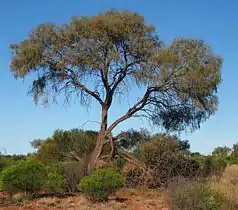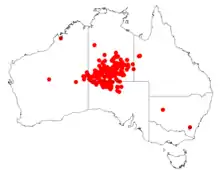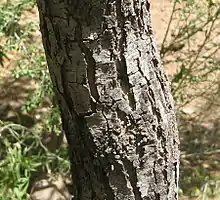Acacia estrophiolata
Acacia estrophiolata, commonly known as ironwood,[1] southern ironwood,[2] desert ironwood[3] or utjanypa,[4] is a tree native to Central Australia.
| Southern ironwood | |
|---|---|
 | |
| Scientific classification | |
| Kingdom: | Plantae |
| Clade: | Tracheophytes |
| Clade: | Angiosperms |
| Clade: | Eudicots |
| Clade: | Rosids |
| Order: | Fabales |
| Family: | Fabaceae |
| Clade: | Mimosoideae |
| Genus: | Acacia |
| Species: | A. estrophiolata |
| Binomial name | |
| Acacia estrophiolata | |
 | |
| Occurrence data from AVH | |
Description
It is a graceful, pendulous shade tree, which grows from about 4 to 16 metres (13 to 52 ft) tall[5] and has a trunk with a diameter of up to about 0.45 m.[6] It has a spreading crown that becomes weeping as the tree matures.[1] Young plants have rigid branches and short straight phyllodes that appear in clusters as trees mature the branches become pendulous and the light green spiky phyllodes in crease in length but are no longer clustered.[1] It has a heavy bloom of spherical pale yellow flowers after winter rains.
The tree has a slow growth rate and is both drought and frost tolerant.[1]
Taxonomy
The species was first formally described by botanist Ferdinand von Mueller in 1882 as part of the work Definitions of some new Australian plants as published in Southern Science Record. It was reclassified as Racosperma estrophiolatum by Leslie Pedley in 1987 then returned to the genus Acacia in 2001.[2]
It is closely related to Acacia excelsa and more distantly related to Acacia dolichophylla.[5]
The type specimen was collected near the Finke River in the Northern Territory by H.Kempe.[5]
Distribution
The tree is found in north western parts of South Australia,[4] southern parts of the Northern Territory and eastern parts of the Pilbara and Goldfields regions of Western Australia.[3]
It is usually found in areas with about 220–350 mm/year of average rainfall.[6]
A. estrophiolata grows mostly on sandy alluvial flats in sandy well drained soils, found as scattered trees among tall open shrubland and open woodland communities.[5]
Uses
Food
Traditionally, Australian Aborigines would use the gum from the tree as a sweet bushtucker treat. Its name in the Arrernte language of Central Australia is Ngkwarle athenge arlperle. It is still sometimes eaten today.

The gum is snapped off the branches, either clear or red. It is then ground and mixed with a little water, then left to set again to a chewable gum, and eaten with a small stick.
Forage
The tree makes good forage for livestock.[6] The seeds are edible and are 28.9% protein.[7]

See also
References
- "Acacia estrophiolata Ironwood" (PDF). Arid Zone Trees. Retrieved 13 September 2018.
- "Acacia estrophiolata F.Muell. Southern Ironwood". Atlas of Living Australia. Global Biodiversity Information Facility. Retrieved 13 September 2018.
- "Acacia estrophiolata". FloraBase. Western Australian Government Department of Parks and Wildlife.
- "Acacia estrophiolata (Leguminosae) Utjanypa". Seeds of South Australia. Government of South Australia. Retrieved 13 September 2018.
- "Acacia estrophiolata". WorldWideWattle. CSIRO. Retrieved 13 September 2018.
- "Acacia estrophiolata F. Muell". FAO. 9 July 2008. Archived from the original on 9 July 2008.
- "Food Standards Australia New Zealand". 2007. Archived from the original on 2007-09-14. Retrieved 2007-05-25.
- Dr.Fish. "Traditional Aboriginal medicine practices in the Northern Territory" (PDF). Government of Northern Territory. Archived from the original (PDF) on 2007-09-08. Retrieved 7 September 2007.
- "Archived copy" (PDF). Archived from the original (PDF) on 2007-09-08. Retrieved 2007-05-25.CS1 maint: archived copy as title (link)
- "Sunshine Wattle (German)". Retrieved 7 September 2018.